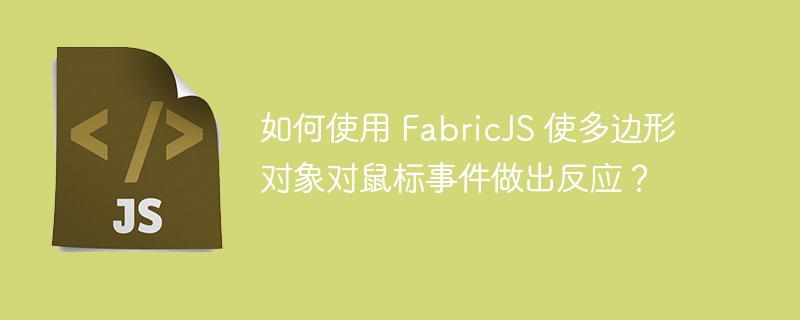Heim >Web-Frontend >js-Tutorial >Wie kann man mit FabricJS ein Polygonobjekt auf Mausereignisse reagieren lassen?
Wie kann man mit FabricJS ein Polygonobjekt auf Mausereignisse reagieren lassen?
- WBOYWBOYWBOYWBOYWBOYWBOYWBOYWBOYWBOYWBOYWBOYWBOYWBnach vorne
- 2023-08-31 14:37:08797Durchsuche

Wir können ein Polygon-Objekt erstellen, indem wir eine Instanz von fabric.Polygon erstellen. Ein Polygonobjekt kann als jede geschlossene Form charakterisiert werden, die aus einer Reihe verbundener gerader Liniensegmente besteht. Da es eines der Grundelemente von FabricJS ist, können wir es auch einfach anpassen, indem wir Eigenschaften wie Winkel, Deckkraft usw. anwenden. Wir verwenden die Ereignisse mouseup und mousedown, um zu demonstrieren, wie Polygonobjekte auf vom Benutzer ausgelöste Mausereignisse reagieren.
Grammatik
polygon.on(“mouseup”, callbackFunction); polygon.on(“mousedown”, callbackFunction);
Beispiel 1: Zeigen Sie, wie ein Objekt auf Mouseup-Ereignisse reagiert
Sehen wir uns ein Codebeispiel an, um zu sehen, wie ein Polygonobjekt reagiert, wenn das mouseup-Ereignis ausgelöst wird. Das mouseup-Ereignis tritt ein, wenn der Benutzer die linke Maustaste loslässt. Sobald das mouseup-Ereignis ausgelöst wird, beträgt die Strichstärke hier 33.
<!DOCTYPE html>
<html>
<head>
<!-- Adding the Fabric JS Library-->
<script src="https://cdnjs.cloudflare.com/ajax/libs/fabric.js/510/fabric.min.js"></script>
</head>
<body>
<h2>Displaying how the object reacts to the mouseup event</h2>
<p>
You can select the object and release the left mouse button to see that the stroke width has changed
</p>
<canvas id="canvas"></canvas>
<script>
// Initiate a canvas instance
var canvas = new fabric.Canvas("canvas");
canvas.setWidth(document.body.scrollWidth);
canvas.setHeight(250);
// Initiate a polygon instance
var polygon = new fabric.Polygon(
[
{ x: 0, y: 0 },
{ x: 0, y: 50 },
{ x: 50, y: 50 },
{ x: 50, y: 0 },
],
{
left: 100,
top: 30,
fill: "red",
stroke: "blue",
strokeWidth: 2,
objectCaching: false,
}
);
// Adding it to the canvas
canvas.add(polygon);
// Using the mouseup event
polygon.on("mouseup", () => {
polygon.set("strokeWidth", 33);
canvas.renderAll();
});
</script>
</body>
</html>
Beispiel 2: Zeigen Sie, wie ein Objekt auf ein Mousedown-Ereignis reagiert
Schauen wir uns ein Codebeispiel an, um zu sehen, wie ein Polygonobjekt reagiert, wenn das Ereignis „mousedown“ ausgelöst wird. Wenn der Benutzer die Taste drückt, tritt das Ereignis „mousedown“ ein. Hier können wir sehen, dass das Objekt auf das Mousedown-Ereignis reagiert, indem es seine Strichstärke von 33 auf 2 ändert.
<!DOCTYPE html>
<html>
<head>
<!-- Adding the Fabric JS Library-->
<script src="https://cdnjs.cloudflare.com/ajax/libs/fabric.js/510/fabric.min.js"></script>
</head>
<body>
<h2>Displaying how the object reacts to the mousedown event</h2>
<p>
You can press the left mouse button to trigger the mousedown event to see that the stroke width has changed
</p>
<canvas id="canvas"></canvas>
<script>
// Initiate a canvas instance
var canvas = new fabric.Canvas("canvas");
canvas.setWidth(document.body.scrollWidth);
canvas.setHeight(250);
// Initiate a polygon instance
var polygon = new fabric.Polygon(
[
{ x: 0, y: 0 },
{ x: 0, y: 50 },
{ x: 50, y: 50 },
{ x: 50, y: 0 },
],
{
left: 100,
top: 30,
fill: "red",
stroke: "blue",
strokeWidth: 33,
objectCaching: false,
}
);
// Adding it to the canvas
canvas.add(polygon);
// Using the mousedown event
polygon.on("mousedown", () => {
polygon.set("strokeWidth", 2);
canvas.renderAll();
});
</script>
</body>
</html>
Fazit
In diesem Tutorial zeigen wir anhand zweier einfacher Beispiele, wie man mithilfe von FabricJS dafür sorgt, dass ein Polygonobjekt auf Mausereignisse reagiert.
Das obige ist der detaillierte Inhalt vonWie kann man mit FabricJS ein Polygonobjekt auf Mausereignisse reagieren lassen?. Für weitere Informationen folgen Sie bitte anderen verwandten Artikeln auf der PHP chinesischen Website!
In Verbindung stehende Artikel
Mehr sehen- Eine eingehende Analyse der Bootstrap-Listengruppenkomponente
- Detaillierte Erläuterung des JavaScript-Funktions-Curryings
- Vollständiges Beispiel für die Generierung von JS-Passwörtern und die Erkennung der Stärke (mit Download des Demo-Quellcodes)
- Angularjs integriert WeChat UI (weui)
- Wie man mit JavaScript schnell zwischen traditionellem Chinesisch und vereinfachtem Chinesisch wechselt und wie Websites den Wechsel zwischen vereinfachtem und traditionellem Chinesisch unterstützen – Javascript-Kenntnisse

